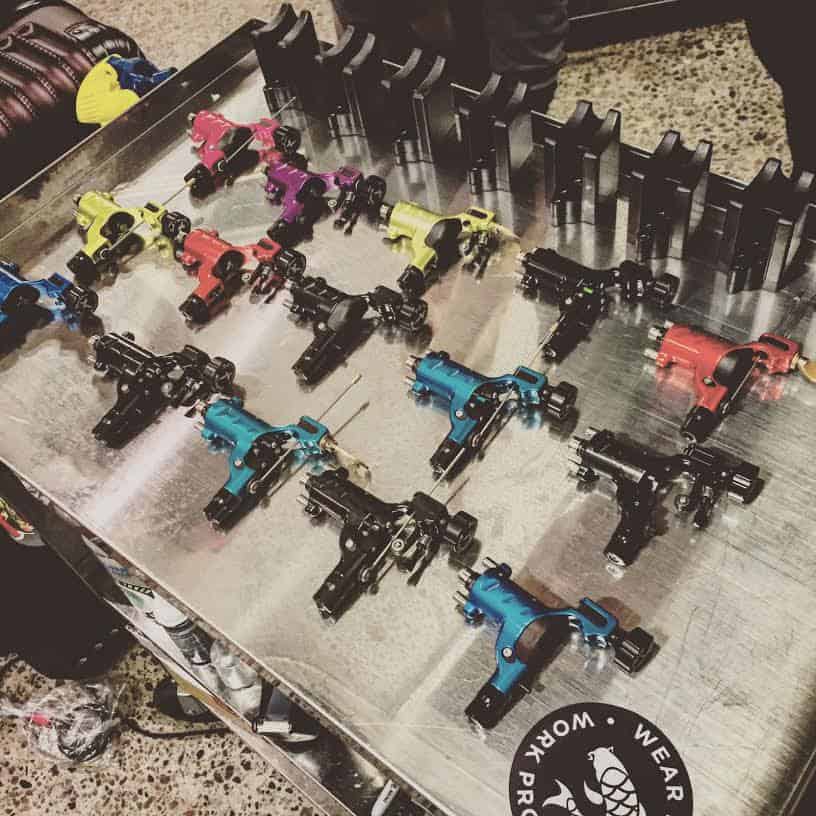Getting a tattoo is a big decision. Picking a great design for your new tattoo only adds to the stress. With so many great styles and designs available, it can be overwhelming.
Whether it’s your first tattoo or your 100th, a small design or a full-sleeve, lots of thought goes into the decision. You need to be happy with the final outcome, so no matter what others suggest or think looks cool it’s important to stay true to yourself and your vision.
That said, it still helps to know a bit about the history of the art form and it’s different styles to find a design that’s right for you.
You can have your tattoo artist make a design for you, create your own, or work together to refine one. Either way, familiarising yourself with tattoo art styles from past and present can inform your choice and help you make a meaningful decision with confidence.
By publishing this article we’re hoping to share some insights into picking a design. We want to inform you so you can come to the decision that’s right for you when you’re ready.
 This Traditional period of tattoo art began roughly around the beginning of the 20th century and is marked by the emergence of tattoo artists like Norman Keith Collins, known as Sailor Jerry, Amund Dietzel, known as the “Master in Milwaukee,” and Bert Grimm. It’s also frequently associated with traditional Japanese tattooing, a practice which is still around today.
Western tattooing is characterised by simple yet evocative designs in bold black outlines and only solid colours from a limited palette. Some of the technology we have today was not as advanced or didn’t exist, so tattoo artists of the day created designs which were within their means to execute effectively.
Old School tattoo artists favoured designs like mermaids, pin-up girls, anchors, and hearts, to name a few. This simplicity of Old School tattoos is due in part to the stigma which surrounded the art form and the contemporary association with sailors, criminals, and lower-class people.
This stigma may have deterred some great artists who had aptitude and were interested in experimenting with the medium. Fewer artists meant less experimentation, and the art form was more stagnant that it otherwise may have been.
This Traditional period of tattoo art began roughly around the beginning of the 20th century and is marked by the emergence of tattoo artists like Norman Keith Collins, known as Sailor Jerry, Amund Dietzel, known as the “Master in Milwaukee,” and Bert Grimm. It’s also frequently associated with traditional Japanese tattooing, a practice which is still around today.
Western tattooing is characterised by simple yet evocative designs in bold black outlines and only solid colours from a limited palette. Some of the technology we have today was not as advanced or didn’t exist, so tattoo artists of the day created designs which were within their means to execute effectively.
Old School tattoo artists favoured designs like mermaids, pin-up girls, anchors, and hearts, to name a few. This simplicity of Old School tattoos is due in part to the stigma which surrounded the art form and the contemporary association with sailors, criminals, and lower-class people.
This stigma may have deterred some great artists who had aptitude and were interested in experimenting with the medium. Fewer artists meant less experimentation, and the art form was more stagnant that it otherwise may have been.
 While the Old School style is aesthetically conservative, New School tattoo designs represent a bold departure from tradition. Such designs can be complex, multi-faceted shapes which blend colours and make use of gradients.
As the stigma around tattoos dissipated with time and experimentation was encouraged, the industry started to experience tremendous innovation. With this evolution came more realism, as technology enabled artists to create designs which visually represents the world around them.
Some of the techniques which characterise the New School of tattoo art are shading, contrast, abstract interpretation, and less use of bold, definitive outlines. The style encourages novelty and self-expression.
If you love experimenting and have an eye for detail, this style might be a good way to represent your idea. You could even consider blending elements of the two styles.
While the Old School style is aesthetically conservative, New School tattoo designs represent a bold departure from tradition. Such designs can be complex, multi-faceted shapes which blend colours and make use of gradients.
As the stigma around tattoos dissipated with time and experimentation was encouraged, the industry started to experience tremendous innovation. With this evolution came more realism, as technology enabled artists to create designs which visually represents the world around them.
Some of the techniques which characterise the New School of tattoo art are shading, contrast, abstract interpretation, and less use of bold, definitive outlines. The style encourages novelty and self-expression.
If you love experimenting and have an eye for detail, this style might be a good way to represent your idea. You could even consider blending elements of the two styles.
Old School vs. New School: What You Should Know
Broadly speaking, tattoo art is divided into two epochs: Old School and New School. Although evidence shows that tattooing has been around for thousands of years, many choose to define the styles based on the history of modern western tattooing.Traditional Tattoo Design Style
 This Traditional period of tattoo art began roughly around the beginning of the 20th century and is marked by the emergence of tattoo artists like Norman Keith Collins, known as Sailor Jerry, Amund Dietzel, known as the “Master in Milwaukee,” and Bert Grimm. It’s also frequently associated with traditional Japanese tattooing, a practice which is still around today.
Western tattooing is characterised by simple yet evocative designs in bold black outlines and only solid colours from a limited palette. Some of the technology we have today was not as advanced or didn’t exist, so tattoo artists of the day created designs which were within their means to execute effectively.
Old School tattoo artists favoured designs like mermaids, pin-up girls, anchors, and hearts, to name a few. This simplicity of Old School tattoos is due in part to the stigma which surrounded the art form and the contemporary association with sailors, criminals, and lower-class people.
This stigma may have deterred some great artists who had aptitude and were interested in experimenting with the medium. Fewer artists meant less experimentation, and the art form was more stagnant that it otherwise may have been.
This Traditional period of tattoo art began roughly around the beginning of the 20th century and is marked by the emergence of tattoo artists like Norman Keith Collins, known as Sailor Jerry, Amund Dietzel, known as the “Master in Milwaukee,” and Bert Grimm. It’s also frequently associated with traditional Japanese tattooing, a practice which is still around today.
Western tattooing is characterised by simple yet evocative designs in bold black outlines and only solid colours from a limited palette. Some of the technology we have today was not as advanced or didn’t exist, so tattoo artists of the day created designs which were within their means to execute effectively.
Old School tattoo artists favoured designs like mermaids, pin-up girls, anchors, and hearts, to name a few. This simplicity of Old School tattoos is due in part to the stigma which surrounded the art form and the contemporary association with sailors, criminals, and lower-class people.
This stigma may have deterred some great artists who had aptitude and were interested in experimenting with the medium. Fewer artists meant less experimentation, and the art form was more stagnant that it otherwise may have been.
Old School Style
Old School-style designs are still used in modern tattooing. Many people choose the aesthetic style for its association with tradition, patriarchy, liberty, freedom, faith, and love. The style has come to be iconic and can carry deep meaning, making it a popular choice to this day. Don’t think you are limited to the designs created in this style a century ago. If you favour simplicity and minimalism, you can look to Old School designs as inspiration for how to express your idea.New School Tattoo Design
 While the Old School style is aesthetically conservative, New School tattoo designs represent a bold departure from tradition. Such designs can be complex, multi-faceted shapes which blend colours and make use of gradients.
As the stigma around tattoos dissipated with time and experimentation was encouraged, the industry started to experience tremendous innovation. With this evolution came more realism, as technology enabled artists to create designs which visually represents the world around them.
Some of the techniques which characterise the New School of tattoo art are shading, contrast, abstract interpretation, and less use of bold, definitive outlines. The style encourages novelty and self-expression.
If you love experimenting and have an eye for detail, this style might be a good way to represent your idea. You could even consider blending elements of the two styles.
While the Old School style is aesthetically conservative, New School tattoo designs represent a bold departure from tradition. Such designs can be complex, multi-faceted shapes which blend colours and make use of gradients.
As the stigma around tattoos dissipated with time and experimentation was encouraged, the industry started to experience tremendous innovation. With this evolution came more realism, as technology enabled artists to create designs which visually represents the world around them.
Some of the techniques which characterise the New School of tattoo art are shading, contrast, abstract interpretation, and less use of bold, definitive outlines. The style encourages novelty and self-expression.
If you love experimenting and have an eye for detail, this style might be a good way to represent your idea. You could even consider blending elements of the two styles.


